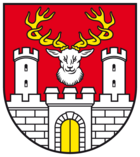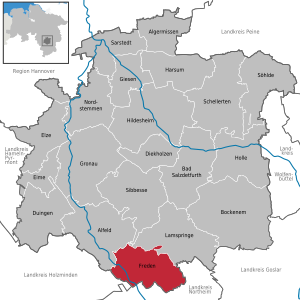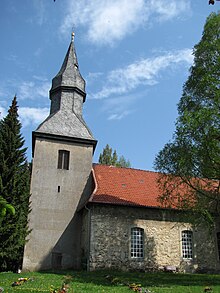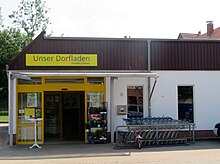Freden (leash)
| coat of arms | Germany map | |
|---|---|---|

|
Coordinates: 51 ° 56 ' N , 9 ° 54' E |
|
| Basic data | ||
| State : | Lower Saxony | |
| County : | Hildesheim | |
| Height : | 127 m above sea level NHN | |
| Area : | 53.49 km 2 | |
| Residents: | 4682 (Dec. 31, 2019) | |
| Population density : | 88 inhabitants per km 2 | |
| Postal code : | 31084 | |
| Area code : | 05184 | |
| License plate : | HI, ALF | |
| Community key : | 03 2 54 042 | |
| Community structure: | 10 districts | |
| Association administration address: | Am Schillerplatz 4 31084 Freden (Leine) |
|
| Website : | ||
| Mayor : | Wolfgang Heimann ( independent ) | |
| Location of the municipality of Freden (Leine) in the Hildesheim district | ||
Freden (Leine) is a municipality in the district of Hildesheim in Lower Saxony .
geography
Geographical location
Freden is located southeast of Alfeld and northwest of Bad Gandersheim between the Selter and Sackwald mountain ranges on the Leine .
Community structure
The following districts are identified for the municipality of Freden (Leine):
- Everode
- Freden (Leine) with Meimerhausen
- Landwehr , consisting of Eyershausen , Ohlenrode and Wetteborn
- Winzenburg with Westerberg, Klump and Schildhorst
history
middle Ages
The place was first mentioned in 1068 as Fredenon . Fredenon was an archdeacon district with county rights in the place Grossfreden, which was subordinate to the Hildesheim bishop.
In 1959, animal bones were found on the ash stone during quarry work in the Selter ridge near Freden. Excavations revealed a C 14 age determination of a Upper Paleolithic reindeer hunter camp from the time 15,000 BC. Until then, no older settlement remains in Central Europe were recorded. The Leinetal is very productive for old age finds, for example a bronze clasp from the 7th century BC was found in the Apenteiche near Winzenburg. Found, also Roman coins from the period from 100 BC. to 100 AD belong to the finds.
The Leine separated the places Groß-Freden ( belonging to Gau Aringo around 1000 ) and Klein-Freden ( belonging to Gau Flenithi ). In 1068 Henry IV gave some places west of the Leine, including Fredenon (Groß-Freden), the Hildesheim bishop.
In 1235 the fragmentation of Saxony led to the separation of the Hildesheim diocese. The diocese received secular rights. From this point on, the bishop called himself Fürst ( Principality of Hildesheim ). 1344 built the Lords of Freden the Castle House Freden , and in 1347 they acquired from the Prince Bishop, the village wholesale Freden. They soon passed the castle on to the Lords of Wettberg. Their successors, the Lords of Rheden, operated from the castle as robber barons . As a result, the castle was besieged and destroyed in 1402.
Modern times
After the Hildesheim collegiate feud in 1519/23, the Winzenburg office (including large and small Freden) belonged to the Principality of Braunschweig-Wolfenbüttel from 1523 to 1643 .
It was not until 1863–1867, when the three-field farming was linked and ended with the start of crop rotation with sugar beets, that rural living conditions improved. The pressure to emigrate eased, and there was also no need to go to Holland . After the establishment of the empire in 1871, trade, trade and industry began to develop rapidly. There was already a glassworks in Westerberg (green glass) in 1744 and the glassworks in Schildhorst (white glass) in 1793. Railway construction began in 1852; In 1854 Freden was reached.
In 1869 the Obermann brothers founded a shoe last factory in Winzenburg. The boom came in 1871 with the construction of a cast glass factory for Deutsche Spiegelglas AG in Freden, which ceased operations in 1936. The lime works on Selter began operations in 1890. The steel leash bridge was built in 1894. In 1896 the "Hohenzollern" potash shaft was sunk and in 1900 the first potash salt was extracted. In 1908, after a fire, the Obermann shoe last factory was rebuilt. In 1910, Freden had its economic peak. 1,800 people were employed in four companies. The station handled two freight trains a day. The 16 large chimneys needed a lot of coal to generate energy.
At the beginning of the 20th century, Groß Freden had 1748 and Klein Freden 1216 inhabitants.
The First World War (coal and sales shortages) and the inflationary developments in 1922/23 affected the companies economically, so that from 1925 to 1936 the entire industry of Fredens fell into disrepair. The successor companies active during the Second World War, such as "Deutsche Fasstoff" and Brinker Eisenwerke, with a total of around 1000 workers, were only employers for a few years.
During the Second World War, an explosive bomb fell on Klein Freden on February 20, 1944: three people were killed and seven injured, a residential building and a barn were destroyed, and four houses were slightly damaged. On February 21, 1944, Groß Freden was hit by high explosive bombs and incendiary bombs, causing only minor damage to buildings and injuring one resident.
Place names
Old names of the place are 1100–1200 Vreden, 1068 Fredenon, 1158 Vreden, 1178 Freten and 1179–80 Vreden. Based on the “Freþ-un-, Freþ-en-” approach, the development to the modern name can be traced without any problems. The place name is put to "friðu" for "peace". In English, “frith” exists for “forest”. This "friþ-" for "forest" is also used here in the base of Freden. An interpretation as “forest” is plausible and more convincing than a connection with “peace, protection”, given the location of the place in a wooded area. The place name is an ancient Germanic name.
Incorporations
In 1949, large and small Freden politically united to form the municipality of Freden (Leine). In July 1965, the integrated municipality of Freden (Leine) with the municipalities of Everode, Freden, Winzenburg, Eyershausen, Ohlenrode and Wetteborn was created through a voluntary merger . Meimerhausen was added on March 1, 1974. On November 1, 2016, the joint congregation was converted into the unitary congregation Freden (Leine).
politics
Municipal council
The Council of the municipality of Freden has been working for the last municipal election one of four women and eleven Council councilors following parties:
| Local election | SPD | Flat share Freden | CDU | Non-party | Green | FB | total |
|---|---|---|---|---|---|---|---|
| September 11, 2016 1 | 7th | 4th | 3 | 1 | - | - | 15 seats |
| September 11, 2011 | 9 | 2 | 3 | - | 1 | - | 15 seats |
| September 10, 2006 | 8th | 3 | 3 | - | - | 1 | 15 seats |
| September 9, 2001 | 7th | 4th | 2 | - | - | 2 | 15 seats |
Current mayor (full-time)
Due to the transformation of the integrated municipality of Freden into the unified municipality of Freden, the election of a full-time mayor on September 11, 2016 became necessary, from which Wolfgang Heimann (independent) emerged as the winner with 54.3% of the votes. His deputies are Ines Hoffmann (SPD), Wilfried Heimann (CDU) and Günter Thiel (SPD).
Former mayor of the municipality (honorary)
- Rüdiger Paulat (2010-2016)
- Dieter Schubert (2001-2010)
Local council (core town Freden)
The local council of Freden consists of a councilwoman and six councilors from the following parties:
- SPD: 2 seats
- CDU: 2 seats
- WG Freden: 3 seats
(Status: local election on September 11, 2016)
Mayor (core town Freden)
The mayor of Freden is Wolfgang Heimann (non-party). His deputy is Hartmut Hennecke (CDU).
coat of arms
The draft municipal coat of arms of the municipality of Freden comes from the heraldic coat of arms painter peoples Gustav , which all arms in the Hanover region has designed. After the amalgamation of Klein- and Groß-Freden, the new municipality adopted the coat of arms of Klein-Freden with the approval of the Lower Saxony Minister of the Interior . The award took place on January 12, 1950.
| Blazon : “In red a silver castle with a battlement wall , a projecting gate, two round battlement towers and a closed golden gate; A silver deer head with golden fourteen-point antlers looking out over the gate. " | |
| Justification for the coat of arms: The whole “part of the village on the mountain” was once built like a castle, with the church and its fixed tower in the center as the core work and the last place of refuge. The room to the east of the St. Laurentius Church is still called “Behind the Burghof” today, and the cellars of the adjacent courtyard consist of huge vaults with loopholes and contain the beginnings of underground, now buried and walled-up corridors, which the legend has a lot to say about . The stag's head as a symbol is supposed to identify the castle as the Fredener; for the family of the Knights of Freden, whose castle rose south of the village, used the stag as a heraldic animal. |
traffic
Freden is connected to the road network via federal highway 3 , which is located immediately west of the municipality. The place also has a stop on the Leine valley route . There are hourly train connections with the private railway company Metronom to Hanover and Göttingen .
Culture and sights
Buildings
The Protestant churches of St. Georg (Groß Freden) and St. Laurentius (Klein Freden) are located in Freden. There was also a New Apostolic and a Catholic Church.
- St. George rises on a hill above the Leine. The church has a west tower 25 m high with a base area of 7 m × 7 m made of quarry stone from the late Middle Ages with some very small windows reminiscent of loopholes - St. George may have been a fortified church earlier. Today's nave - 23.5 m long, 10.5 m wide and 6.75 m high - was built in the classical style in 1818/19 . Inside, the segmented wooden arched ceiling, the late Classicist pulpit altar and the ceiling painting from around 1900 are noteworthy.
- St. Laurentius rises on a hill in the center of Klein Fredens. The nave dates from 1782 - as an inscription above the entrance shows - while the tower was built during the Gothic period and renovated in 1667. The tower with its windows, which can still be recognized today as earlier loopholes, possibly also served as a defense tower. In the interior of the church, the wooden pulpit altar from the end of the 18th century is particularly striking.
- The Catholic Church of St. Hedwig , built in 1971, was profaned in 2005 and then demolished; today the nearest Catholic church is in Winzenburg, 3 km away .
- The New Apostolic Church was profaned in 2014. The next New Apostolic Church is in Alfeld, 10 km away .
Events
Every Friday after Ash Wednesday, winter is driven out in Freden. This custom has been practiced in Freden for over 100 years. As a sinner and symbolic figure, Hinrich Koarl Kümmelneese is set on fire by the population and thrown onto a leash from the bridge.
The International Fredener Music Days take place every year at the beginning of August. Chamber music from all eras is performed here. The program is mostly dedicated to one or more specific topics. The main venues are the Fredener Zehntscheune, built in 1739, the St. Georg Church and the Fagus factory in Alfeld , built by Walter Gropius .
Infrastructure
Freden has a primary school, kindergarten, sports fields and an outdoor swimming pool. In the center there are two pharmacies and restaurants. Freden became known beyond the borders of the Hildesheim district through the project “Our village shop”.
Personalities
Sons and daughters of the church
- Friedrich Lorenz (1897–1944), Catholic religious priest (Oblate of the Immaculate Virgin Mary), executed as a Nazi opponent
- Rudolf Murray (* 1898), government building officer, head of the state police headquarters in Düsseldorf
- Friedrich Mennecke (1904–1947), Nazi doctor who participated as an accomplice in the mass killing of the so-called euthanasia program of National Socialism
- Hanns Hubmann (1910–1996), photographer and photojournalist, he mainly photographed political and sporting events, from the Third Reich to the late years of the old Federal Republic he followed the powerful with his camera
- Carl-Heinz Evers (1922–2010), education specialist and politician (SPD), Berlin School Senator from 1963 to 1970 and was considered one of the fathers of the German comprehensive school
- Werner Schlimme (1924–2010), politician (CDU), 1986–1996 Lord Mayor of Wolfsburg, 1996 honorary citizen of Wolfsburg
People connected to the community
- Carl Wiederhold (1863–1961), painter, made the design for the painting of the St. Laurentius Church in Freden (1906, today only a small area of a curtain painting is visible)
- Carl Loges (1887–1958), sports and gymnastics teacher, died in Freden
- Walter Köster (1903–1991), teacher and writer, head of the adult education center, head of the tourist office and local homeworker, he experienced the end of the Second World War in a hospital in Freden
- Alfred Salomon (1910–2006), Protestant pastor, author and member of the Confessing Church, worked as a parish pastor in Freden from 1947
- Hans-Winfried Jüngling (1938–2018), Jesuit and theologian, lived with his mother and sister in Freden from 1946 and attended elementary school there
Web links
Individual evidence
- ↑ State Office for Statistics Lower Saxony, LSN-Online regional database, Table 12411: Update of the population, as of December 31, 2019 ( help ).
- ^ W. Keil: Neumanns Orts- und Verkehrslexikon, Vol. 1. Leipzig 1905, p. 277.
- ^ Hermann Meyer-Hartmann: destination 52092 N 09571 O - The Hildesheim area in the air war 1939-1945. Hildesheim 1985, p. 128.
- ^ Hermann Meyer-Hartmann: destination 52092 N 09571 O - The Hildesheim area in the air war 1939-1945. Hildesheim 1985, p. 131.
- ^ Jürgen Udolph (research): The "place name researcher". In: website NDR 1 Lower Saxony . Archived from the original on July 29, 2016 ; accessed on March 9, 2019 .
- ^ Federal Statistical Office (ed.): Historical municipality directory for the Federal Republic of Germany. Name, border and key number changes in municipalities, counties and administrative districts from May 27, 1970 to December 31, 1982 . W. Kohlhammer, Stuttgart / Mainz 1983, ISBN 3-17-003263-1 , p. 205 .
- ↑ Lower Saxony State Chancellery (ed.): Law on the new formation of the community Freden (Leine), district Hildesheim . Lower Saxony Law and Ordinance Gazette (Nds. GVBl.). No. 22/2015 . Hanover December 15, 2015, p. 401 ( digitized version ( memento of May 13, 2019 in the Internet Archive ) [PDF; 278 kB ; accessed on July 1, 2019] p. 19).
- ↑ a b Members of the local council Freden. In: Website of the municipality of Freden. Retrieved April 30, 2019.
- ↑ Preliminary final result of the mayoral election on September 11, 2016 in Freden. In: NDR website. Retrieved September 15, 2016.
- ↑ a b Members of the local council Freden. In: Website of the municipality of Freden. Retrieved April 30, 2019.
- ^ Directory of the mayors and mayors in the Hildesheim district. In: www.diekholzen.de. Retrieved June 24, 2017 (DOCX; 72.1 kB).
- ↑ District of Hanover (ed.): Wappenbuch district of Hanover . Self-published, Hanover 1985.
- ^ A b Wilhelm Barner : Coat of arms and seal of the Alfeld district . Rebinding. Lax GmbH & Co. KG, Hildesheim 1998 ( digitized version of the text part of the first edition from 1940 [PDF; 10.0 MB ; accessed on June 10, 2019]).
- ^ Georg Dehio : Handbook of German Art Monuments. Bremen, Lower Saxony . Ed .: Dehio Association. Deutscher Kunstverlag, Munich / Berlin 1992, ISBN 3-422-03022-0 , p. 476 .









